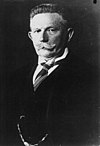List of political parties in Azmara
Jump to navigation
Jump to search
This article is incomplete because it is pending further input from participants, or it is a work-in-progress by one author. Please comment on this article's talk page to share your input, comments and questions. Note: To contribute to this article, you may need to seek help from the author(s) of this page. |
Parties with Representation
| Party logo | Party name | Leader | Folksmot seats | Landsmot seats | Provincial Presidents | Euclean Parliament seats |
Ideology | |
|---|---|---|---|---|---|---|---|---|
| Workers' Party Arbeiderpartii |
 Sofija Freidriksdohter |
51 / 150
|
18 / 75
|
4 / 8
|
8 / 22
|
|||
| The Workers' Party was formed in 1925 as the moderate wing of the syndicalist Azmaran Section of the Workers' International merged with the Sotirian socialist National Association to provide a unified voice for the Azmaran trade union movement and found itself catapulted to power after the 1932 General Strike. The party would go on to form the government for 21 consecutive years between 1933 and 1954, in coalition with The Radicals, introducing many key reforms that established the Azmaran welfare state. Later it would alternate in power with centre-right coalitions, yet between 1981 and 1993 was out of power for 12 years before returning under a more centrist course. It would then form a government between 2008 and 2011 and in 2017 re-entered government under a more left-wing stance under Eryk Jorśsun. | ||||||||
| Gold Flame Gyldflam |
 Freidrik Aleksanderssun |
30 / 150
|
14 / 75
|
1 / 8
|
4 / 22
|
|||
| Gold Flame was formed by the bulk of the liberal Forþgaaner faction in the run up to the 1903 election as the party moved to a more centrist stance to combat the rise of socialism. The party became the government in 1906, introducing women's suffrage and proportional representation. The party later formed a government with the National Coalition in 1924, which controversially brought Azmara into the Great War on the Entente side yet was bought down in 1932 by a general strike. Repositioning itself in the centre after the war, it eventually moved to a more right-wing stance in the 1980's, implementing a series of neoliberal reforms in an attempt to stimulate the economy and cemented itself as the main centre-right party in Azmara, being in government between 1999 and 2005 and between 2011 and 2017. | ||||||||
| The Radicals Radikaalen |
 Ana Freidriksdohter |
19 / 150
|
10 / 75
|
1 / 8
|
3 / 22
|
|||
| The Radicals were formed in 1922 as the New Liberal Party from a group of left-liberal members of the Folksmot who broke away from Gold Flame to support the Workers' Party in government. It rebranded to the Radicals in 1924 and became known as a strong critic of Azmaran involvement in the Entente. It formed a government with the Workers' Party after the 1933 election and the 1932 General Strike, and has often governed in coalition with the Workers' Party, yet has also been in coalition with the Sotirian Democrats and Gold Flame, even going so far as to lead the government between 1969 and 1975. The party is known for being a strong supporter of feminism, LGBT rights, environmentalism and federalism. | ||||||||

|
Sotirian Democrats Sortiren Folksrâgelen |
 Aansgaar Jonsun |
16 / 150
|
16 / 75
|
1 / 8
|
3 / 22
|
||
| The Sotirian Democrats were founded in 1937 by the moderate wing of the former National Coalition party in an attempt to form a new conservative force in Azmaran politics after the collapse of the latter in the 1933 election. The party would first enter government in 1954 in a coalition with Gold Flame, committing itself to the newly-created welfare state while maintaining support for traditional values. The party was very influential between 1960 and 1987, being in government for 15 out of 27 years, and would remain in government between 2005 and 2017 under various coalitions. It is currently in opposition. | ||||||||
| File:Green Party.png | Green Party Groonpartii |
 Aleksander Erykssun |
14 / 150
|
6 / 75
|
0 / 8
|
2 / 22
|
||
| The Green Party was formed in 1985 by environmentalist, socially progressive and anti-nationalist student protest groups as a vehicle to bring attention to these issues. It entered the Folksmot in the 1993 election, gaining three seats. It would contest the 1996 and 1999 elections on a joint list with the Socialist Party, which established both parties as major forces on the national stage. The party would enter a coalition with the Workers' Party, the Radicals and the Sotirian Democrats in 2008 under Niina Hermansdohter, which would remain in place until the party withdrew in 2011 citing its opposition to austerity. It re-entered government in 2017 in coalition with the Workers' Party and the Socialist Party, with party veteran Liis Jonsdohter being made Deputy Prime Minister and Foreign Secretary. Her resignation in 2018 led to her replacement by Aleksander Erykssun, the party's long term leader. | ||||||||
| People's Party Folkspartii |
 Hank Hankssun |
6 / 150
|
2 / 75
|
0 / 8
|
1 / 22
|
|||
| The People's Party was founded in 2002 by the merger of the pan-Weranicist Destiny Party, the agrarian Centre Party and the Euclosceptic Direct Democrats into a new force against increased Euclean integration. The party soon won its first seats in the Euclean Parliament, yet failed to carry this success to the 2005 general election. However, as the Euclean Recession hit, the party saw a mass uptick in popular support and under the leadership of Hank Hankssun diversified its platform to include opposition to immigration, especially from Irfanic nations, combining this with economic populism and anti-austerity positions. This approach paid off, with the party getting 15 seats in 2008 and 16 seats in 2011. It backed up a coalition of Gold Flame and the Sotirian Democrats after 2011, which caused the party to lose support and it eventually withdrew support, triggering the 2014 election, in which the party suffered. | ||||||||
| Socialist Party Sośalistiśpartii |
 Karl Kryssun |
5 / 150
|
3 / 75
|
0 / 8
|
1 / 22
|
|||
| The Socialist Party was founded in 2003 by the merger of the left-wing populist New Deal and the syndicalist Azmaran Section of the Workers' International. New Deal split from the Workers' Party in 1987 in opposition to the party's "professional socialism" policies, while the Azmaran Section of the Workers' International had split from the Workers' Party in 1921 in opposition to the party's co-operation with the Radicals. Both parties had continuously maintained representation in the Folksmot for the past few election cycles, and in the 2005 election the new party won 7 seats, largely from voters anxious at the onset of recession. The party increased its performance in the 2008 and 2011 elections , in which it won 15 and 16 seats respectively, and in 2014 it won 18 seats as Workers' Party support collapsed. The party has, however, lost support to the Workers' Party under Jorśsun, receiving only 7 seats, yet in this election it also entered government for the first time. | ||||||||
| Free Alliance 08 Friibinden 08 |
Collective leadership | 4 / 150
|
4 / 75
|
1 / 8
|
0 / 22
|
Internal Factions | ||
| Free Alliance 08 was formed as an alliance between three regionalist parties: the Haadlandisk Vangaard, the Parti for Hûtklif and the Nordberg People's Party to contest the 2008 elections. The parties themselves had seen successes in previous elections: the former two parties both had representation in the previous parliament as individual parties, while the Nordberg People's Party had won a seat in 2002 but not in 2005. The alliance broke through in Haadland and Hytklif, and has been consistently represented in both legislative houses since 2008. The party advocates for a federal Azmara and devolution to the country's eight provinces, as well as redistributive efforts towards the more deprived provinces. On many issues, due to the divide between the liberal and social democratic politics of Vangaard and the NPP, and the agrarianism and Sotirian democracy of the Parti, the Free Alliance allows for free votes of its members. | ||||||||
| Grey Party Grejpartii |
 Niina Karlsdohter |
3 / 150
|
1 / 75
|
0 / 8
|
0 / 22
|
|||
| The Grey Party was formed in 2013 over concerns that the incumbent government of Jon Jorśsun did not have the interests of the elderly population of Azmara at heart, and ran in the 2014 elections, gaining one seat in the Province of Westmaark, which increased to three seats in the 2017 election. Its platform contains a strong opposition to raising the retirement age, commitments to Azmara's pension system, increased funding for health and social care, increased accessibility for those with disabilities and scepticism towards further Euclean integration. | ||||||||
| New Azmara Ny Azmaara |
Collective leadership | 2 / 150
|
1 / 75
|
0 / 8
|
0 / 22
|
|||
| New Azmara originates from the Tolerant Azmara pressure group set up late 2013 in response to the 2013 student protests, which advocated on behalf of non-Euclean immigrants against what it saw as a fundamentally discriminatory society. The pressure group launched the party in 2016 in order to contest the 2017 elections, claiming that none of the established parties offered adequate solutions for the unique problems of Azmara's immigrant communities. It gained five seats in the election, finding support largely in the largest cities of Aalmsted, Jorś-Hylager and Stajnensby, and formed a confidence and supply agreement with the government of Eryk Jorśsun. | ||||||||
Parties with regional representation
Parties with local representation
Former parties
| Party logo | Party name | First leader | Last leader | Establishment | Dissolution | Ideology | |
|---|---|---|---|---|---|---|---|
| Progress Party Forþgaanenpartii |
 Mikel Hankssun |
 Þurisas Leifssun |
1855 | 1905 | |||
| Formed in 1855 in order to advocate for further social reform to create an Azmaran nation-state after the revolution, the Progress Party was a radical-liberal party advocating for universal education, protections of civil liberties, separation of church and state, free trade and protection of private property, and for the creation of a cohesive national culture for all Azmarans. The party was dominant for much of the early years of the republic, gaining support from the growing industrial working classes and the professional middle classes, yet towards the end of its life started to decline as the working-class turned to socialist options and the party moved to the political centre through the process of sinistrisme, eventually merging with other liberals into the Gold Flame alliance in 1905. | |||||||
| Alliance for the Commonwealth Binden for de Gemenwelþ |
 Jorś Wilhjâlmssun |
 Þurisas Leifssun |
1855 | 1923 | |||
| The Alliance for the Commonwealth was founded by Jorś Wilhjâlmssun in opposition to what he perceived as a corruption of the republican movement by the Progress Party. The party drew heavily on the personal popularity of Wilhjâlmssun, who had served as a resistance leader throughout the Revolution and as a result became known as the Jorśites in popular conversation. The party had very different views as to nation-building than the Progress Party, opposing the party's attempts to make a cohesive culture and take political power away from the countryside, believing that the nation should be united by its Amendist Sotirian faith and by a strong, charismatic, democratically elected leader. The party thus gained large support from the countryside, being voted for by farmers, fishermen, craftsmen, traders and artisans, and became a major force in the late 19th and early 20th centuries before merging with other right-wing forces into the National Coalition in 1923. | |||||||
| Northern Alliance Nordbinden |
 Aleksaander fan Westhaaltun |
1856 | 1869 | ||||
| The Northern Alliance was founded to represent an alternative to the Azmaran liberal nationalism offered by other political factions in the early republic, advocating for the creation of a democratic republic of consisting of Werania, Sunrosia, Azmara, Buckland and Wealdland, saying that the cultural similarities between the five nations warranted the creation of a common nation-state. Politically, it supported many of the reforms of the Progress Party, yet opposed attempts at creating a cohesive culture in Azmara as it saw this as an attempt to define Azmara separately from its Weranic brothers, and emphasised equality between Amendists and Catholics. The party competed for a similar support base to the Progress Party, yet failed to win over large amounts of support and wound up in 1869. | |||||||
| Party of the Right Partii âb de Reht |
 Aansgaar van Ruyksvaal |
1856 | 1861 | ||||
| The Party of the Right was formed by representatives in the first Folksmot who did not support the newly-created republic, with many of its members supporting the reinstatement of the Azmaran monarchy and the retention of the estates of the realm. However, the group failed to win much support from the growing urban and middle classes or the industrial working classes, and the only seats that it managed to win were in rural areas which had benefitted from the concept of noblesse oblige. However, in 1861 the party was banned on account of its aims to end the Commonwealth, and its leadership arrested in a move known as the Republican Ascendancy. | |||||||
| Free-minded Party Friiþenkenpartii |
 Loki Leifssun |
1884 | 1897 | ||||
| The Free-minded Party was founded by intellectuals and Amendist pastors who were concerned about the plight of the industrial working-class, pointing to the poor conditions many of them lived in and dissenting from the Progress Party, which had sided with the enterprising factory owners on many issues. It attempted to establish a government safety net to guarantee basic living conditions for workers, and pass a charter guaranteeing fundamental rights to workers. Making a key breakthrough in 1885 among working-class neighbourhoods of large industrial cities such as Aalmsted, Jorś-Hylager and Kyningsmer, it sided with the Progress Party on many political and constitutional issues while negotiating with other factions to pass its reforms, being successful in regulating working hours and establishing basic social insurance and poor relief programs. However, suffered after 1894 as the Azmaran Section of the Workers' International (ADAA) began to compete for the same support base and after a disappointing 1897 result the party dissolved as some of its members returned to the Progress Party and others merged with the ADAA | |||||||
| Azmaran Section of the Workers' International Azmaariś Daal âb de Arbeider-Alþyydlyk |
 Yuri Nemtsov |
 Jorśena Freisdohter |
1891 | 2003 | |||
| The Azmaran Section of the Workers' International (ADAA) was formed in Heuthenberg by Yuri Nemtsov and dockyard workers in order to advocate for Nemtsov's vision of a workers' revolution to bring about a society based on common ownership of resources and rule by the working class and trade unions. The party soon began to compete against the Free-minded Party for urban working-class support, quickly winning the support of much of the industrial working-class and entering the Folksmot in the 1893 Heuthenberg by-election. In 1921, the party emerged as the largest in Azmara and formed the country's first socialist-led government with the National Association and dissident members of Gold Flame, yet would suffer splits as in 1923 a nationalistic splinter in the Azmaran Socialist Party crossed the floor, and in 1925 a majority of its membership left the party to form the Workers' Party with the National Association in order to provide a united left-wing voice. The rump party continued on as a representative of the far-left, gaining some working-class support, before merging in 2003 with New Deal to form the Socialist Party. | |||||||
| National Association Þyydiś Bund |
 Reverend Lorenc Lorencssun |
 Aleks Freissun |
1909 | 1925 | |||
| The National Association was formed in 1909 by a group of priests and social workers who were concerned by the working-class drift towards the ADAA and believed that social reform to ensure equality and a decent standard of living for the working-classes was necessary to prevent this. The party therefore supported generous reforms that they believed to be inspired by the social teachings of Jesus Sotirias, advocating for significant changes to healthcare and housing to make them more accessible to the working classes and the restructuring of factories and other industrial facilities to give workers a say in their administration. The party offered support to the early 20th century Gold Flame governments and the progressive reforms that they made, and after seeing their support explode in the wake of the Great Collapse, formed a government with the ADAA and dissident Liberals between 1921 and 1923 in which they introduced basic unemployment insurance. In 1925 the party merged with the bulk of the ADAA to form the Workers' Party as a united left-wing opposition. | |||||||
| Party of the Azmaran Middle Class Partii âb den Azmaariś Midelstand |
 Maþis Hankssun |
1914 | 1923 | ||||
| The Party of the Azmaran Middle Class was formed in 1914 after the Great Collapse by members of Azmara's traditional middle class of small business owners, craftsmen, farmers and artisans who felt that the Alliance for the Commonwealth no longer represented their interests. A right-wing political organisation, it was strictly opposed to communism and other forms of socialism, and advocated an economic policy advocating both a distrust of excessive government intervention and large corporations, while wishing for government intervention to prop up struggling small enterprises and for protectionist tariffs to protect these enterprises from foreign competition. The party supported the Alliance for the Commonwealth in government between 1918 and 1921, and in 1923 it merged with the Alliance and the Azmaran Socialist Party to form the National Coalition. | |||||||
| New Liberals Ny-Forþgaaners |
 Jorś Helmutsson |
1922 | 1924 | ||||
| The New Liberals were formed members of Gold Flame who supported the ADAA-ÞB government of 1921-3 after being expelled from the party. The party, while still supporting property rights and markets, was a strong advocate for civil liberties and for welfare reforms, and sponsored many of the new government's attempted reforms. It later merged with independents who had left Gold Flame over opposition to the co-operation with the National Coalition 1923-4, and other liberal forces in the country, forming The Radicals to contest the 1924 election. | |||||||
| Azmaran Socialist Party Azmaariś Sośalistiśpartii |
 Peitur Jonssun |
1923 | 1923 | ||||
| The Azmaran Socialist Party was a short-lived splinter from ADAA inspired by the Weranic Syndicalist Union, rejecting the class conflict narrative of the latter in favour of a revolution from above and class collaborationism in order to overcome capitalism and advocating for a strong Azmaran nation. While a very small political force, it had a major impact on Azmaran politics as its members teamed up with the Alliance for the Commonwealth, Gold Flame and the Party of the Azmaran Middle Class to oust the ADAA-led government, later merging with the Alliance and the Party to form the National Coalition. | |||||||
| National Coalition Þyydiś Samening |
 Þurisas Siimunssun |
1923 | 1933 | ||||
| The National Coalition was formed in 1923 as a result of a merger of the Alliance for the Commonwealth, the Azmaran Socialist Party and the Party for the Azmaran Middle Class to consolidate anti-communist political organisations within Azmara, initially forming a government with Gold Flame. However, the party managed to win a majority in 1924 by unifying the right-wing vote and appealing to both middle and working class voters, and formed a centralised government focused on welfare reform, anti-trade union policies, Azmaran cultural unity and family values. The National Coalition government also entered the Great War on the Entente side, and over the course of the war the party became increasingly authoritarian, suppressing dissent and suspending elections. However, war losses, food shortages and the militarisation of industrial workspaces led to the 1932 General Strike, which caused the government's downfall and replacement by an interim coalition of other parties. The party fractured after the 1933 election, in which it suffered a heavy defeat to the newly-formed Workers' Party. | |||||||
| Farmers' Party Buurenspartii |
 Aarne Hermanssun |
 Mâþijas Hankssun |
1934 | 1969 | |||
| The Farmers' Party was formed out of some of the remnants of the National Coalition by more moderate members, who distanced themselves from some of the more authoritarian tendencies of the government, hoping to provide a new voice for the right-wing of Azmaran politics. Sceptical of the welfare state and nationalisation policies of the Workers' Party-Radical government, they advocated for a protectionist economic policy focused on small businesses and traditional social values. The party was also fairly isolationist, opposing the United Nations of Euclea and the Euclean Community. It placed second in the 1935, 1938 and 1941 elections, yet it failed to oust the incumbent government. Furthermore, their opposition to the creation of the Euclean Community would lead to their downfall, as the party's calls for withdrawal from the organisation failed to catch on and its support plummeted. After losing their electoral representation in 1960, the party eventually dissolved in 1969. | |||||||